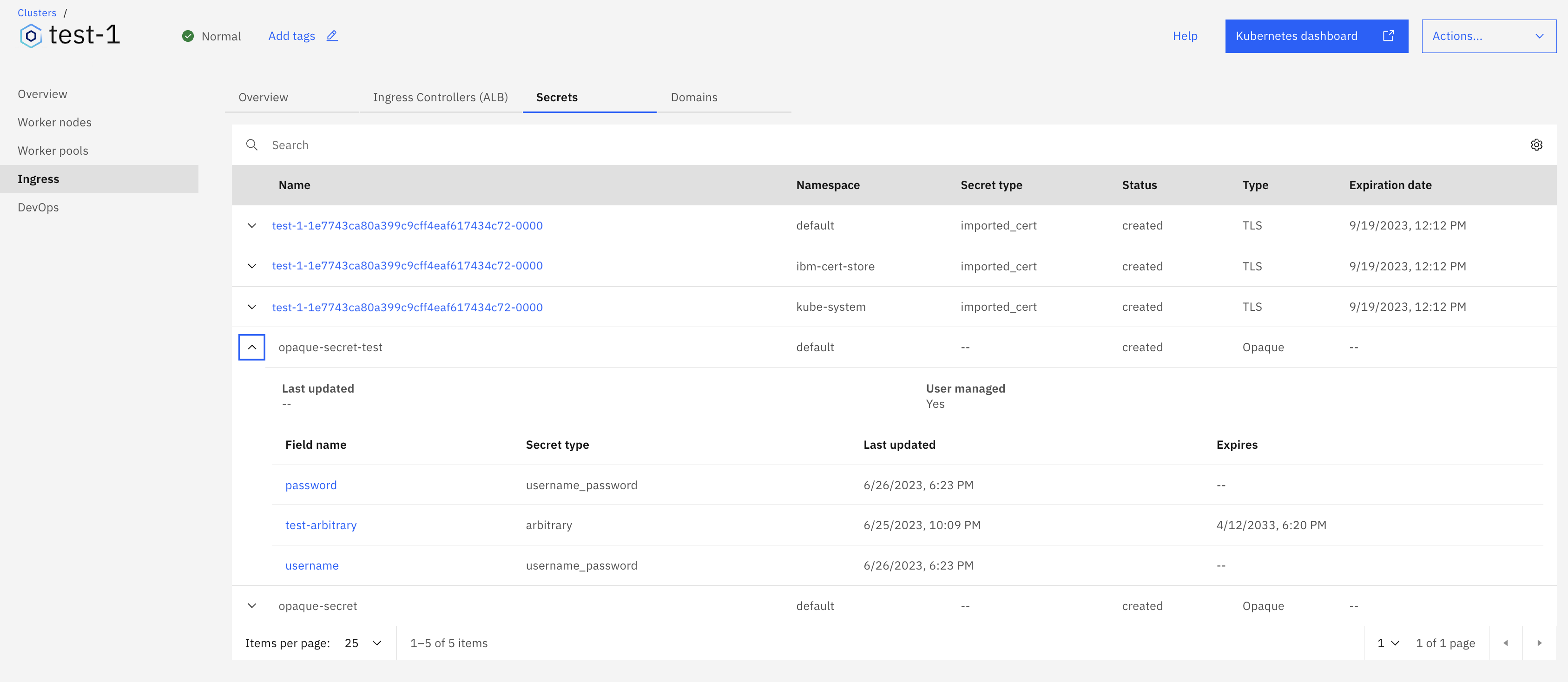
In this blog post, we explore the practical implementation of utilizing Terraform on IBM Cloud to create and manage secrets by seamlessly integrating your IBM Cloud Kubernetes Service with IBM Cloud Secrets Manager.
Previously, this functionality to manage TLS and non-TLS certificates and secrets was primarily accessed through the CLI using the namespace ibmcloud ks ingress secret. This API enables users to create an “Ingress secret” resource by passing Secrets Manager secret CRNs to the API to establish a managed corresponding secret in their Kubernetes cluster. Notably, any updates made to the secrets within the Secrets Manager instance are automatically reflected within the associated Kubernetes cluster, ensuring synchronization between the two environments.
Architecture and behavior
The IBM Cloud Kubernetes Service reconciles the created Ingress secrets in the following way:

- The user has an existing IBM Cloud Secrets Manager instance and IBM Cloud Kubernetes Service instance.
- The user registers the Secrets Manager instance to ensure its secret CRNs will be synchronized between the Secrets Manager secret and corresponding Ingress secret(s).
- The user then creates an IBM Cloud Kubernetes Ingress secret that can either be an Opaque or TLS secret with a Secrets Manager CRN (ID). This creates a backing resource in the cloud that correlates the secret CRN to the ClusterID/SecretName/SecretNamespace.
- IBM Cloud Kubernetes Service fetches the Secrets Manager secret via the CRN.
- IBM Cloud Kubernetes Service creates a Kubernetes secret in the cluster with the values of the CRN(s).
- IBM Cloud Kubernetes Service ensures that the secrets values stay in sync with the corresponding Secrets Manager secret CRN.
Benefits
By utilizing the integration with IBM Cloud Kubernetes Service and IBM Cloud Secrets Manager, you can leverage the following benefits:
- Seamlessly create and manage Secrets Manager secrets with built-in autorotation for enhanced security.
- Effortlessly provision Kubernetes secrets using the secret CRN of any Secrets Manager instance you own, ensuring consistent and reliable secret management.
- Automatically synchronize and persist your secrets within your Kubernetes cluster on a regular basis, eliminating the need for manual updates and reducing the risk of outdated secrets.
- Easily track and monitor the expiration dates of your secrets directly from the IBM Cloud console, ensuring timely rotation and preventing potential security vulnerabilities.
- Maintain control over access to your secrets by creating secret groups, allowing you to grant permissions only to approved users and enhancing the overall security of your applications.
Hands-on example
The below example shows an integration of IBM Cloud Kubernetes and IBM Cloud Secrets Manager via a Terraform script. To follow along in the full sample, go to this example. You will provision an IBM Cloud Secrets Manager instance, register it to an IBM Cloud Kubernetes Service, and create managed IBM Cloud Kubernetes Ingress secrets backed by Secrets Manager secrets.
Prerequisites
To follow this example, you will require the following:
Walking through the Terraform script
1. Create an IBM Cloud Secrets Manager instance
Create an IBM Cloud Secrets Manager instance and secret group to host your secrets. Learn more about Creating a Secrets Manager service instance:
resource "ibm_resource_instance" "sm_instance" { name = var.sm_instance_name service = "secrets-manager" plan = var.sm_instance_plan location = var.sm_instance_region timeouts { create = "60m" delete = "2h" } } resource "ibm_sm_secret_group" "sm_secret_group" { instance_id = ibm_resource_instance.sm_instance.guid region = ibm_resource_instance.sm_instance.location name = var.sm_secret_group_name description = var.sm_secret_group_description
}2. Set up service-to-service authorization through IAM
See more about what configurations are needed to enable service-to-service communication:
resource "ibm_iam_authorization_policy" "sm_auth" { source_service_name = "containers-kubernetes" target_service_name = "secrets-manager" roles = ["Manager"]
}3. Register the Secrets Manager instance to the IBM Cloud Kubernetes Service cluster
When you register a Secrets Manager instance to your cluster as the default, all new Ingress subdomain certificates are stored in that instance:
resource "ibm_container_ingress_instance" "instance" { cluster = var.cluster_name_or_id secret_group_id = ibm_sm_secret_group.sm_secret_group.secret_group_id instance_crn = ibm_resource_instance.sm_instance.id is_default = true
}4. Create secrets in Secrets Manager and enable automatic rotation
Create an arbitrary and username credential secret in Secrets Manager. Learn more about different secret types:
resource "ibm_sm_arbitrary_secret" "sm_arbitrary_secret" { instance_id = ibm_resource_instance.sm_instance.guid region = ibm_resource_instance.sm_instance.location endpoint_type = var.sm_endpoint_type name = var.sm_arbitrary_secret_name description = var.sm_arbitrary_secret_description expiration_date = var.sm_arbitrary_secret_expiration_date labels = var.sm_arbitrary_secret_labels secret_group_id = ibm_sm_secret_group.sm_secret_group.secret_group_id payload = var.sm_arbitrary_secret_payload
} resource "ibm_sm_username_password_secret" "sm_username_password_secret" { instance_id = ibm_resource_instance.sm_instance.guid region = ibm_resource_instance.sm_instance.location endpoint_type = var.sm_endpoint_type name = var.sm_username_password_secret_name description = var.sm_username_password_secret_description expiration_date = var.sm_username_password_secret_expiration_date labels = var.sm_username_password_secret_labels secret_group_id = ibm_sm_secret_group.sm_secret_group.secret_group_id rotation { auto_rotate = true interval = 1 unit = "day" } username = var.sm_username_password_secret_username password = var.sm_username_password_secret_password
}5. In the cluster, create a persistent Opaque secret that is backed by the CRN of the secrets in Secrets Manager
Create an Ingress Opaque secret in the cluster. Now, anytime the secrets in Secrets Manager are updated, the corresponding Kubernetes Opaque secret will be updated once a day. The persistence field ensures that if a user inadvertently deletes the secret from the cluster, it will be recreated:
resource "ibm_container_ingress_secret_opaque" "secret_opaque" { cluster = var.cluster_name_or_id secret_name = var.opaque_secret_name secret_namespace = var.opaque_secret_namespace persistence = true fields { crn = ibm_sm_arbitrary_secret.sm_arbitrary_secret.crn } fields { crn = ibm_sm_username_password_secret.sm_username_password_secret.crn }
}Creating the infrastructure
Now that you’ve gone through what each block of the Terraform script will be doing, let’s create the infrastructure.
- Run
terraform initin your directory. - Copy the
main.tfandoutput.tffiles from the example repo. - Create a
.tfvarsfile and fill in the corresponding variables needed. You can learn more about what variables are needed in the variables.tf file. - Run
terraform plan -var-file=<file_name>. - Create the resources with
terraform apply -var-file=<file_name>.
Verifying created resources
Now that these resources are created, go into the IBM Cloud Dashboard to view the created resources under Resource list:
Navigate to the created IBM Cloud Secrets Manager instance and view the created secrets:

Navigate to the IBM Cloud Kubernetes Service, click on Ingress, then select the Secrets tab to view the Opaque secret:

Contact us
This sample serves as a starting point to showcase the benefits and functionality of integrating Terraform with IBM Cloud Kubernetes Service and IBM Cloud Secrets Manager. Feel free to expand and tailor this approach to fit your use case.
If you have questions, engage our team via Slack by registering here and join the discussion in the #general channel on our public IBM Cloud Kubernetes Service Slack.
More from Cloud

CaixaBank CIO Pere Nebot discusses modernizing business operations for an enhanced, customer-centric experience
4 min read – As a leading financial group in Spain, CaixaBank has long been an innovator by taking a technology-first approach by placing innovation, digital transformation, customer experience and sustainable banking at the forefront of its strategy. The bank reportedly serves 20 million customers and is a country leader in digital banking with more than 11 million customers. For years, the bank has been part of IBM’s growing ecosystem of financial institutions and technology partners leveraging IBM Cloud for Financial Services to help…
4 min read

IBM Cloud VPC image lifecycle management
3 min read – Organization is key in any business. With an organization plan, you can plan for the work that is needed, and staying organized helps keep your environment up and running. IBM Cloud VPC image lifecycle management helps you organize your custom images by designating different image statuses, such as “deprecate” and “obsolete.” Keeping your software current is an ongoing process that is essential for any environment to work properly, and it also helps keep security risks to a minimum. You can…
3 min read

IBM announces availability of the high-performance, cloud-native Netezza Performance Server as a Service on AWS
4 min read – The AI revolution is here, but so are the multitude of data challenges that organizations now face to effectively make AI work for them. When it comes to scaling new workloads, traditional cloud data warehouses have left customers with over-provisioning, vendor lock-in, and are limited in their ability to optimize both high performance analytics and AI workloads. Businesses today have a choice: either they self-disrupt or get disrupted by newer and more agile business models. These models have successfully operationalized…
4 min read

Introducing the next generation of Db2 Warehouse: Our cost-effective, cloud-native data warehouse built for always-on, mission-critical workloads
4 min read – We’re thrilled to introduce the general availability of our next generation, cloud-native Db2 Warehouse on Amazon Web Services (AWS). This is a game-changer for organizations looking to optimize costs, improve performance, share data responsibly, and unlock the full potential of their data for analytics and AI. With the next generation of Db2 Warehouse, we’re introducing a host of new capabilities. What’s new? 1. Cut your analytics costs by up to 34×1 The next generation of Db2 Warehouse introduces cloud-native support for…
4 min read
- SEO Powered Content & PR Distribution. Get Amplified Today.
- PlatoData.Network Vertical Generative Ai. Empower Yourself. Access Here.
- PlatoAiStream. Web3 Intelligence. Knowledge Amplified. Access Here.
- PlatoESG. Automotive / EVs, Carbon, CleanTech, Energy, Environment, Solar, Waste Management. Access Here.
- BlockOffsets. Modernizing Environmental Offset Ownership. Access Here.
- Source: https://www.ibm.com/blog/unleashing-terraform-for-kubernetes-secret-management-with-ibm-cloud-kubernetes-service-and-secrets-manager/



